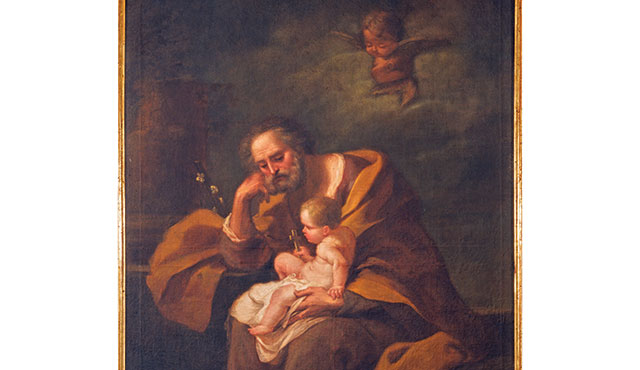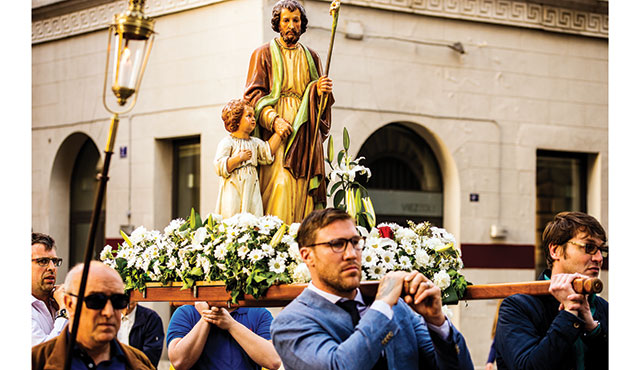The years around 1870 were a fractious time in Rome. Pope Pius IX was trapped behind the Vatican walls and became known as a “prisoner of the Vatican.”
Now, 150 years later, the COVID-19 pandemic has made many in the Catholic community feel like prisoners in their own homes.
So, it is fitting that in the same way Pius IX, in the wake of his virtual imprisonment, declared St. Joseph as the patron of the Unified Catholic Church in December, 1870, that Pope Francis would turn the eyes of the Church back to the foster father of Jesus.
In response to the Pope’s message, the Diocese of Orange is rallying to embrace the call.
Pope Francis proclaimed a special “Year of St. Joseph,” beginning on the Solemnity of the Immaculate Conception 2020 and extending to the same feast in 2021.
In times like these, when it is easy to feel imprisoned and impotent, Pope Francis spoke of the importance of those like Joseph, quiet and unnoticed pillars of their homes and communities, who are “a support and a guide in times of trouble.”
The Pope wrote in his December 8, 2020 Apostolic Letter, “Patris Corde,” or “A Father’s Heart,” that “Saint Joseph reminds us that those who appear hidden or in the shadows can play an incomparable role in the history of salvation.”
The announcement by the Pontiff caught many Church leaders, including those in the Dioceses of Orange, by surprise.
However, they have reacted quickly.
Already on the campus of Christ Cathedral, the Mary Hood Chapel, beneath the iconic 236-foot stainless steel Bell Tower, has been converted into a space for veneration and prayers to St. Joseph. On a pedestal in the center of the tiny circular chapel is a two-foot statue of St. Joseph cradling the infant Jesus.
Outside the chapel is a placard inviting visitors to reflect on and pray to St. Joseph.
Across the diocese, parishioners have been purchasing special seven-day devotional candles with a portrait of Joseph and Jesus on the front and the prayer to St. Joseph in English, Spanish, Vietnamese or Korean.
According to Thomas Ryan, proprietor of Trinity West Liturgical Supplies, which provides church supplies to the diocese, nearly 5,000 candles have already been distributed to parishes by Father Al Baca and the Office for Evangelization and Faith Formation.
Father Baca said the candles had generated a lot of excitement and were helping kick off awareness about St. Joseph.
On Wednesday, March 17, Auxiliary Bishop Timothy Freyer blessed the St. Joseph statue in a ceremony attended by about 40 clergy, parishioners and staff of the Diocese of Orange.
Two days later, during the Feast of St. Joseph, the Youth and Young Adults Ministry began a 33-day consecration of St. Joseph, to extend until the Feast of St. Joseph the Worker.
During the period of consecration, the members of the ministry will meditate on St. Joseph’s patronages: including families, fathers, expectant mothers (pregnant women), explorers, pilgrims, travelers, immigrants, the dying, house sellers and buyers, craftsmen, engineers, and working people in general.
In June, deacons in a virtual men’s retreat on fatherhood, hosted by the
diaconate, will pay special attention and focus on St. Joseph. And in October, a Day of Prayer for priests and spiritual fathers will be conducted, again with special attention to Joseph.
Individual parishes will also conduct prayers and remembrances of
the temporal father of Jesus.
The Year of St. Joseph concludes during celebration of the Feast of
the Immaculate Conception on December 8.
Monsignor Stephen Doktorcyzk, who attended the statue blessing said when Pope Pius IX named Joseph patron of the Universal Church, “he realized St. Joseph had a lot of qualities that were underused.”
St. Joseph is at once one of the most central and yet, strangely, marginalized figures in Catholicism.
The Litany of St. Joseph lists him, among many traits and responsibilities, as “the light of patriarchs,” “spouse of the mother of God,” “diligent protector of Christ” and “head of the Holy Family.”
Pope Pius IX made his proclamation just months after he and the Church had lost control of Rome and the Papal States of central Italy. France, which had guarded the Papal States, had abandoned its barracks and Napoleon Bonaparte had been taken prisoner by enemy Prussia. The capture of Rome on September 20, 1870, completed Italian unification, also known as the Risorgimento, under King Victor Emmanuel II of the House of Savoy.
Perhaps in light of the upheaval and uncertainty of the time, Pope Pius IX turned the Church’s sight inward toward the bedrock strength of humility St. Joseph possessed.
It is a message and view that resonates still.
As Pope Francis framed it, “The aim of this Apostolic Letter is to increase our love for this great saint, to encourage us to implore his intercession and to imitate his virtues and his zeal.”


